Towards Nearly Zero Energy Buildings in Europe: A Focus on Retrofit in Non-Residential Buildings
Abstract
:1. Introduction
2. Deep, Major and Nearly Zero Energy Buildings Renovations
- the Global Buildings Performance Network (GBPN) [19] equates a deep renovation to a reduction in energy consumption for heating, cooling, ventilation and hot water of 75% or more;
- the Entranze Consortium selected as “deep” the renovation level implementing high-grade refurbishment packages (e.g., 30, 20 and 15 cm of insulation on roof, walls and basement; very efficient heating/cooling generators; heat recovery strategies) [20];
- the Zebra 2020 project defines it as deep thermal renovation with more than two thermal solutions (e.g., heating plus insulation of wall/roof, etc.) [10].
3. National Nearly Zero Energy Buildings Definitions
- included energy uses are heating, domestic hot water (DHW), ventilation, and cooling. Auxiliary energy and lighting are taken into account in almost all countries. Several Member States also include appliances and central services;
- the most common choice regarding the energy balance calculation is the difference between primary energy demand and energy generated, over a one year period, and considering annual constant weightings/factors (e.g., primary energy factors);
- single building or building unit are the most frequent indicated physical boundary for the calculation, but the overall impression is that the differences among building unit/site/zone/part need to be better addressed;
- as regards the normalization factors, conditioned area is the most agreed upon choice in Member States. Although other options, such as net floor area and treated floor are selected;
- the most common considered RES option is on-site generation, but many countries also consider external generation and nearby generation (but not always with the same meaning);
- almost all Member States prefer the application of low energy building technologies and available on-site RES. The used technologies are PV, solar thermal, air- and ground-source heat pumps, geothermal, passive solar, passive cooling, wind power, biomass, biofuel, micro combined heat and power (CHP), and heat recovery.
4. Policies Designed to Target Building Renovations
5. Conclusions
Acknowledgments
Author Contributions
Conflicts of Interest
References
- Directive 2012/27/EU of European Parliament and of the Council of 25 October 2012 Energy on Efficiency, Amending Directives 2009/125/EC and 2010/30/EU and Repealing Directives 2004/8/EC and 2006/32/EC. Off. J. Eur. Union 2012, 4, 202–257.
- Directive 2010/31/EU of the European parliament and of the council of 19 May 2010 on the energy performance of buildings. Off. J. Eur. Union 2010, 3, 124–146.
- Congedo, P.M.; Baglivo, C.; D’Agostino, D.; Zacà, I. Cost-optimal design for nearly zero energy office buildings located in warm climates. Energy 2015, 91, 967–982. [Google Scholar] [CrossRef]
- Kapsalaki, M.; Leal, V.; Santamouris, M. A methodology for economic efficient design of Net Zero Energy Buildings. Energy Build. 2011, 43, 3279–3288. [Google Scholar] [CrossRef]
- Lu, Y.; Wang, S.; Shan, K. Design optimization and optimal control of grid-connected and standalone nearly/net zero energy buildings. Appl. Energy 2015, 155, 463–477. [Google Scholar] [CrossRef]
- D’Agostino, D.; Congedo, P.M. CFD modeling and moisture dynamics implications of ventilation scenarios in historical buildings. Build. Environ. 2014, 79, 181–193. [Google Scholar] [CrossRef]
- Marco, F.; Almeida, M.G.; Ana, R.; da Silva, S.M. Comparing cost-optimal and net-zero energy targets in building retrofit. Build. Res. Inf. 2016, 44, 188–201. [Google Scholar]
- Taking Stock of the Europe 2020 Strategy for Smart, Sustainable and Inclusive Growth; European Commission: Brussels, Belgium, 2014.
- Eurostat. Final Energy Consumption by Sector. Available online: http://ec.europa.eu/eurostat/web/energy/data/main-tables (accessed on 23 November 2016).
- Zebra 2020. Nearly Zero Energy Building Strategy 2020—Strategies for a Nearly Zero-Energy Building Market Transition in the European Union. Available online: http://zebra2020.eu/website/wp-content/uploads/2014/08/ZEBRA2020_Strategies-for-nZEB_07_LQ_single-pages-1.pdf (accessed on 23 November 2016).
- D’Agostino, D. Assessment of the progress towards the establishment of definitions of nearly zero energy buildings (nZEBs) in European Member States. J. Build. Eng. 2015, 1, 20–32. [Google Scholar] [CrossRef]
- Buildings Performance Institute Europe (BPIE). Europe’s Buildings under the—A Country-by-Country Review of the Energy Performance of Buildings; BPIE: Brussels, Belgium, 2011. [Google Scholar]
- Fraunhofer Institute for Systems and Innovation Research ISI. Study on Energy Savings Potentials in EU Member States, Candidate Countries and EEA Countries: Final Report for the European Commission Directorate-General Energy and Transport; Institute for Systems and Innovation Research ISI: Karlsruhe, Germany, 2009. [Google Scholar]
- Buildings Performance Institute Europe (BPIE). Building Policies and Programs in the EU-27: EU Overview and Nine Factsheets on ENTRANZE Countries; Buildings Performance Institute Europe: Brussels, Belgium, 2013. [Google Scholar]
- European Parliament. Proposal for a directive of the European Parliament and of the Council on Energy Efficiency and Repealing Directives 2004/8/EC and 2006/32/EC. Available online: http://eur-lex.europa.eu/legal-content/EN/ALL/?uri=CELEX%3A52011PC0370 (accessed on 23 November 2016).
- Report form the Commission to the European Parliament and the Council—Financial Support for Energy Efficiency in Buildings. Available online: https://ec.europa.eu/energy/sites/ener/files/documents/swd_2013_143_accomp_report_financing_ee_buildings.pdf (accessed on 23 November 2016).
- Zacà, I.; D’Agostino, D.; Congedo, P.M.; Baglivo, C. Assessment of cost-optimality and technical solutions in high performance multi-residential buildings in the Mediterranean area. Energy Build. 2015, 102, 250–265. [Google Scholar] [CrossRef]
- Torcellini, P.; Pless, S.; Deru, M.; Crawley, D. Zero Energy Buildings: A Critical Look at the Definition; National Renewable Energy Laboratory and Department of Energy: Golden, CO, USA, 2006. [Google Scholar]
- Global Buildings Performance Network (GBPN). What Is a Deep Renovation Definition; Technical Report; GBPN: Washington, DC, USA, 2013. [Google Scholar]
- Entranze. Cross-Analysis on Member-States’ Plans to Develop Their Building Regulations Towards the NZEB Standard. Available online: http://www.entranze.eu/files/downloads/D5_1_3/ENTRANZE_Integration_of_report_D5.1_D5.2_D5.3_final.pdf (accessed on 23 November 2016).
- Shnapp, S.; Higgins, C.; Gibert, R.S. How Can We Renovate Deeply if We Don’t Know What That is? ECEEE Summer School: Stockholm, Sweden, 2013. [Google Scholar]
- Kephalopoulos, S.; Geiss, O.; Barrero-Moreno, J.; D’Agostino, D.; Paci, D. Promoting Healthy and Energy Efficient Buildings in the European Union, National Implementation of Related Requirements of the Energy Performance Buildings Directive (2010/31/EU), EUR 27665 EN. 2016; in press. [CrossRef]
- European Commission (EC). National Plans for Nearly Zero-Energy Buildings, 2013. Available online: http://ec.europa.eu/energy/en/topics/energy-efficiency/buildings/nearly-zero-energy-buildings (accessed on 23 November 2016).
- D’Agostino, D.; Zangheri, P.; Cuniberti, B.; Paci, D.; Bertoldi, P. Synthesis Report on the National Plans for Nearly Zero Energy Buildings (NZEBs). Available online: http://publications.jrc.ec.europa.eu/repository/bitstream/JRC97408/reqno_jrc97408_online%20nzeb%20report(1).pdf (accessed on 23 November 2016).
- Mohamed, A.; Hasan, A.; Sirén, K. Fulfillment of net-zero energy building (NZEB) with four metrics in a single family house with different heating alternatives. Appl. Energy 2014, 114, 385–399. [Google Scholar] [CrossRef]
- D’Agostino, D. Moisture dynamics in an historical masonry structure: The Cathedral of Lecce (South Italy). Build. Environ. 2013, 63, 122–133. [Google Scholar] [CrossRef]
- Mazzarella, L. Near zero, zero and plus energy buildings: Revised definitions. In Proceedings of the 12th REHVA World Congress CLIMA, Aalborg, Denmark, 22–25 May 2016.
- Kurnitski, J.; Buso, T.; Corgnati, S.; Derjanecz, A.; Litiu, A. NZEB Definitions in Europe. REHVA J. 2014, 51, 6–9. [Google Scholar]
- Report on European Harmonised Policy to Promote RES-H/C. Available online: http://www.res-h-policy.eu/downloads/RES-H%20Policy%20D17%20report-final.pdf (accessed on 23 November 2016).
- Hermelink, A.; Schimschar, S.; Boermans, T. Towards Nearly Zero-Energy Buildings; Definition of Common Principles Under the EPBD, Final Report; European Commission: Brussels, Belgium, 2013. [Google Scholar]
- Congedo, P.M.; D’Agostino, D.; Baglivo, C.; Tornese, G.; Zacà, I. Efficient solutions and cost-optimal analysis for existing school buildings. Energies 2016, 9, 851. [Google Scholar] [CrossRef]
- ODYSSEE–MURE. Energy Efficiency Trends and Policies in the Household and Tertiary Sectors—An Analysis Based on the ODYSSEE and MURE Databases. Available online: http://www.odyssee-mure.eu/publications/br/energy-efficiency-in-buildings.html (accessed on 23 November 2016).
- TABULA Project Team. Typology Approaches for Non-Residential Buildings in Five European Countries—Existing Information, Concepts and Outlook; TABULA Thematic Report No. 3; Institut Wohnen und Umwelt GmbH (IWU): Darmstadt, Germany, 2012. [Google Scholar]
- Ecofys. Panorama of the European Non-Residential Construction Sector; Ecofys: Utrecht, The Netherlands, 2011. [Google Scholar]
- Castellazzi, L.; Zangheri, P.; Paci, D. Synthesis Report on the Assessment of Member States’ Building Renovation Strategies; EUR 27722 EN; Publications Office of the European Union: Luxembourg City, Luxembourg, 2016. [Google Scholar]
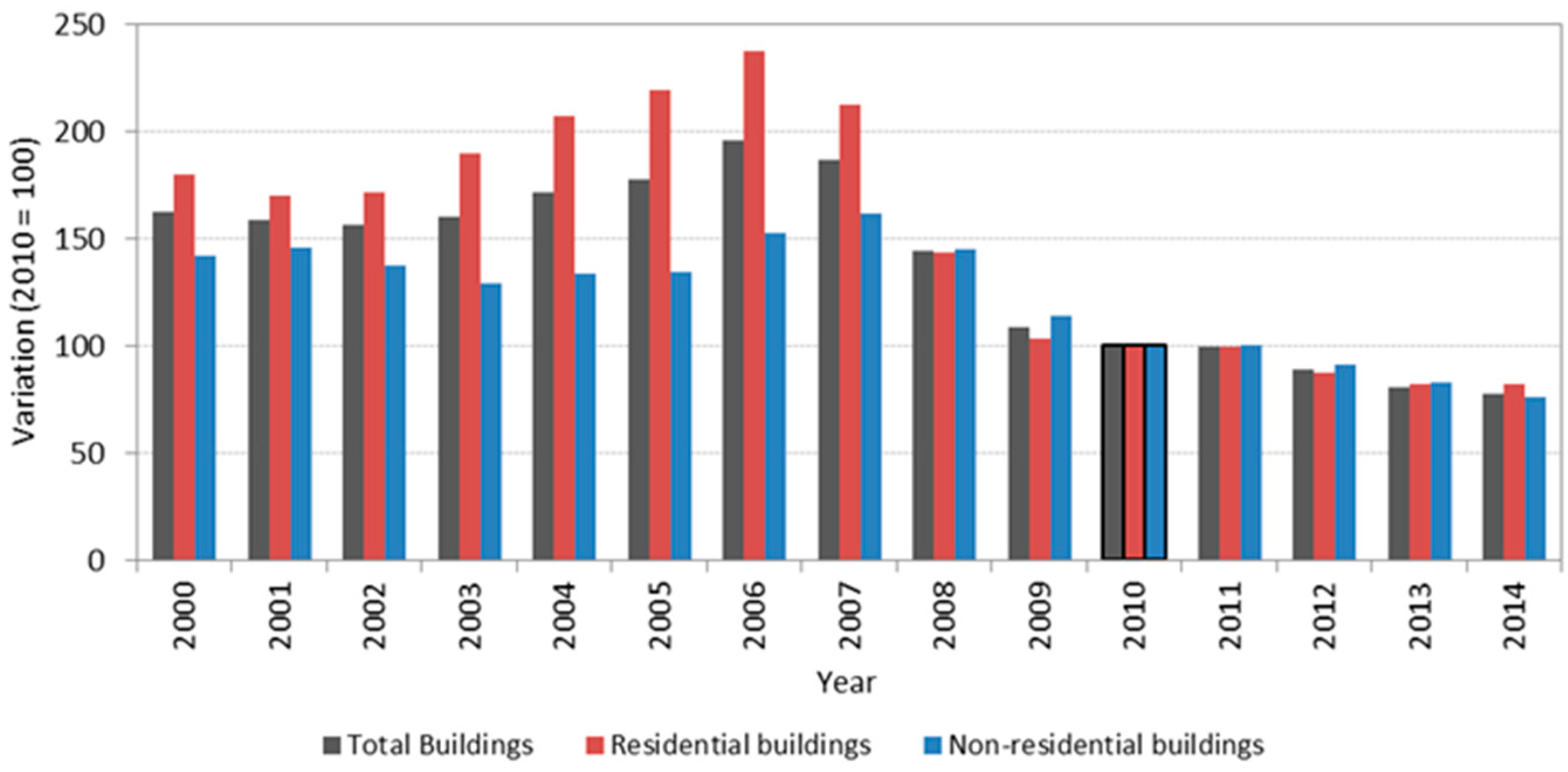
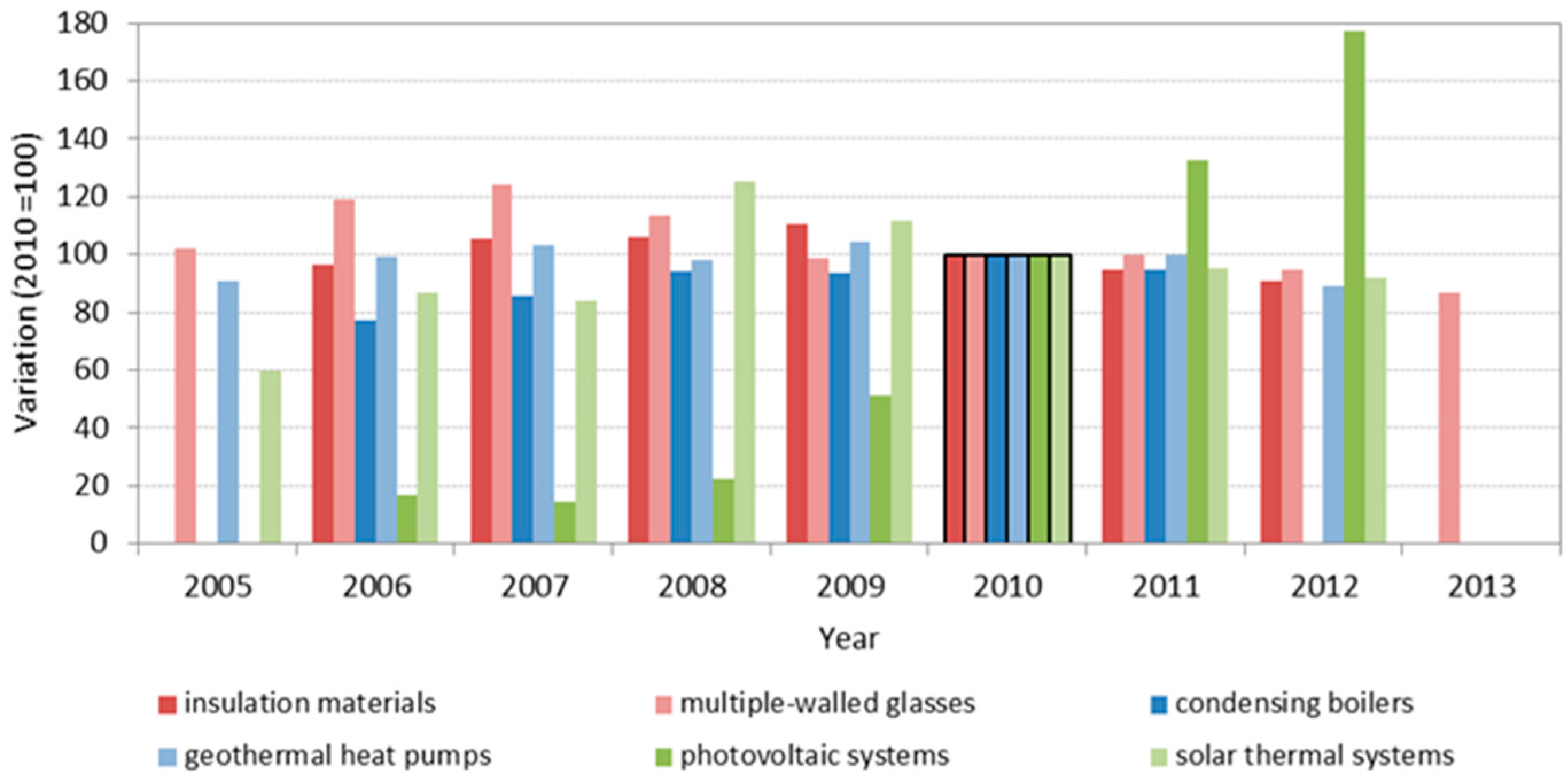
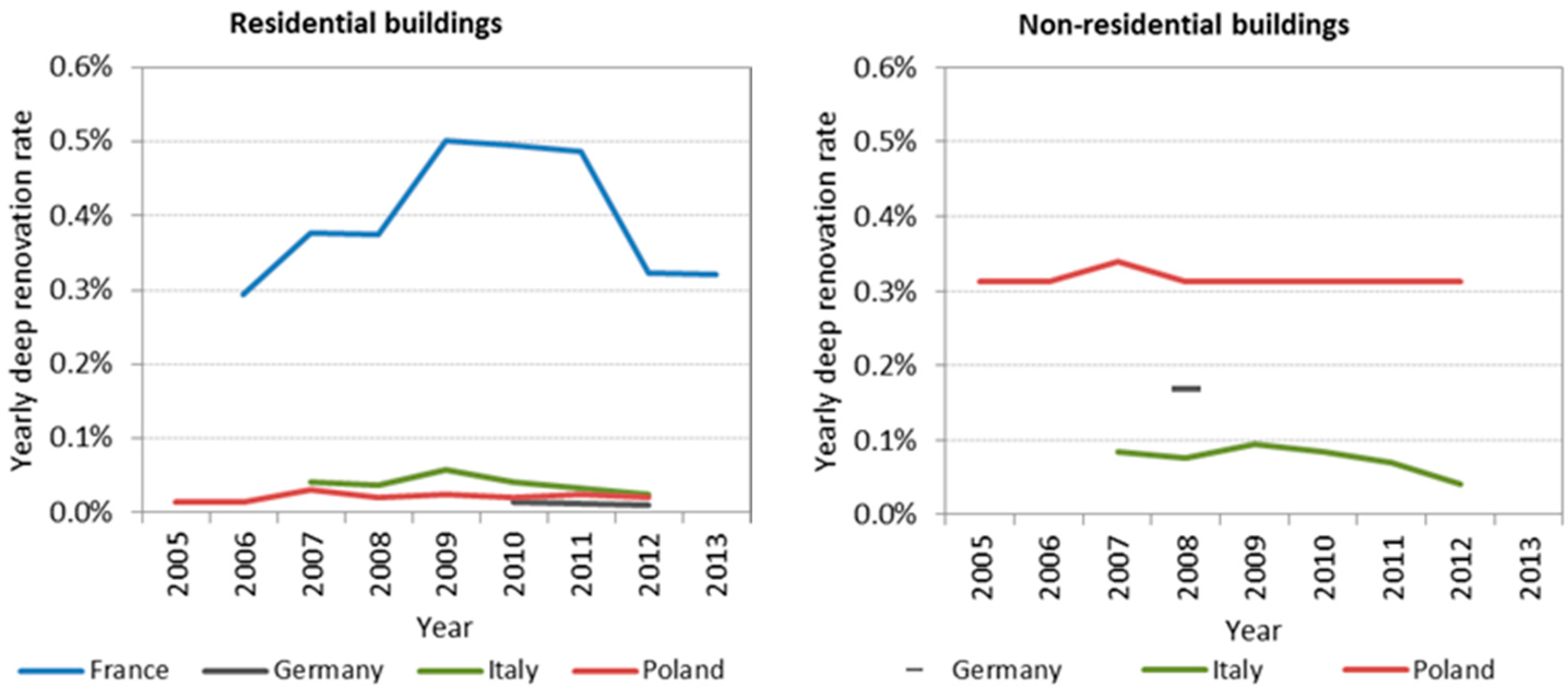
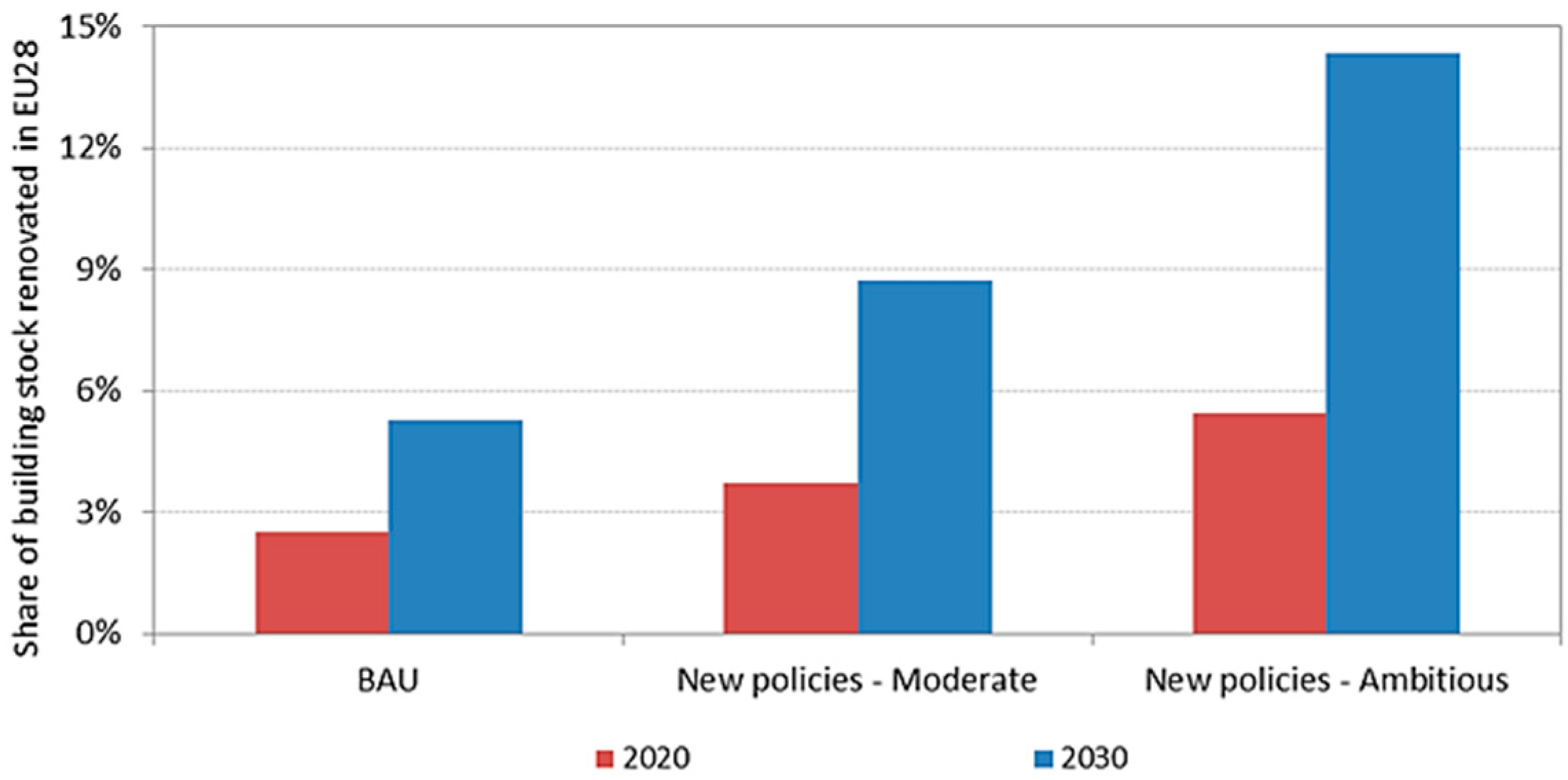
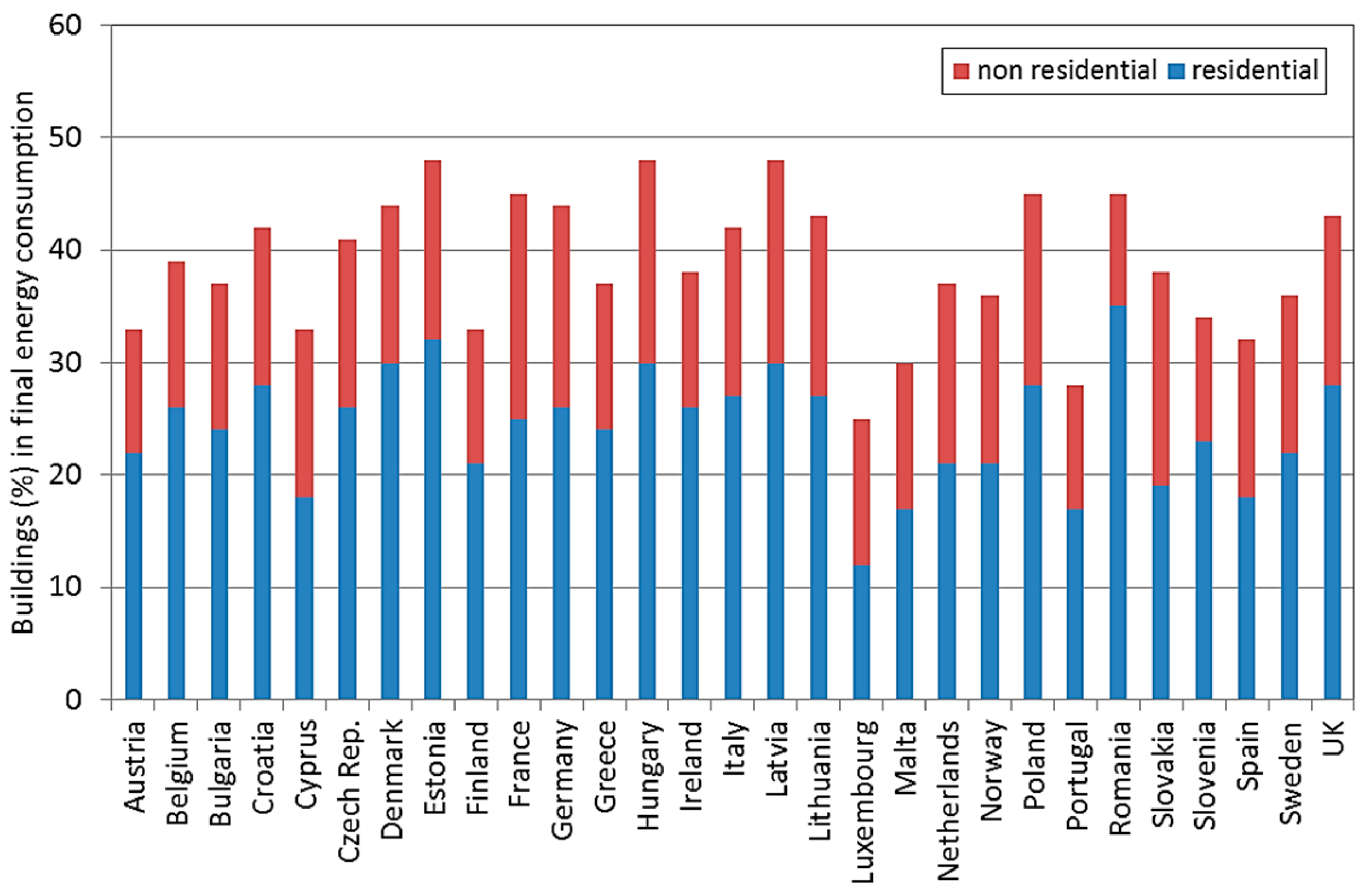

| Type of Renovation | Reference | Definition/Measures |
|---|---|---|
| Minor | BPIE [12] | It reduces final energy consumption up to 30% implementing from one to three improvement measures (e.g., new boiler plant, wall/roof insulation, windows), with an average total project cost of 60 €/m2. |
| Moderate | BPIE [12] | It involves from three to five retrofit improvements resulting in energy reductions in the range 30%–60%, with an average total project cost of 140 €/m2. |
| Deep | EED [1] | It reduces both the delivered and the final energy consumption by a significant percentage compared with the pre-renovation level leading to a very high energy performance. |
| European Parliament report (July 2012) [15] | It reduces both the delivered and the final energy consumption of a building by at least 80% compared with the pre-renovation level. | |
| Commission SWD (2013) [16] | Significant efficiency improvements, typically more than 60%. | |
| GBPN [19] | Reduction in energy consumption for heating, cooling, ventilation and hot water of 75% or more. | |
| Entranze Consortium [14] | Renovation level implementing high-grade refurbishment packages (e.g., 30, 20 and 15 cm of insulation on roof, walls and basement; very efficient heating/cooling generators; heat recovery strategies). | |
| Zebra 2020 project [10] | Deep thermal renovation with more than two improved thermal solutions (e.g., efficient heating plus insulation of wall/roof, etc.). | |
| BPIE [12] | It adopts a holistic approach, viewing the renovation as a package of measures working together, resulting in energy reductions in the range 60%–90%, with an average total project cost of 330 €/m2. | |
| Major | EPBD [2] | Renovation of a building where:
|
| NZEB | EPBD [2] | Renovation that leads to a building that has a very high energy performance […]. The nearly zero or very low amount of energy required should be covered to a very significant extent by energy from RES, including energy from RES produced on-site or nearby. |
| BPIE [12] | It leads to more than 90% final energy saving, with an average total project cost of 580 €/m2. |
| Country | Residential Buildings | Non-Residential Buildings | ||
|---|---|---|---|---|
| (kWh/m2/y or Energy Class) | (kWh/m2/y or Energy Class) | |||
| New | Existing | New | Existing | |
| Austria | 160 | 200 | 170 | 250 |
| Belgium | 45 (Brussels region) | ~54 | (95–2.5) *(V/S) (Brussels region) | ~108 |
| 30 (Flemish region) | 40 (Flemish region) | |||
| 60 (Walloon region) | 60 (Walloon region) | |||
| Bulgaria | ~30–50 | ~40–60 | ~30–50 | ~40–60 |
| Cyprus | 100 | 100 | 125 | 125 |
| Czech Republic | 75%–80% PE | 75%–80% PE | 90% PE | 90% PE |
| Germany | 40% PE | 55% PE | n/a | n/a |
| Denmark | 20 | 20 | 25 | 25 |
| Estonia | 50 (detached house) | n/a | 100 (office buildings) | n/a |
| n/a | 130 (hotels, restaurants) | n/a | ||
| n/a | 120 (public buildings) | n/a | ||
| n/a | 130 (shopping malls) | n/a | ||
| 100 (apartment blocks) | n/a | 90 (schools) | n/a | |
| n/a | 100 (day care centres) | n/a | ||
| n/a | 270 (hospitals) | n/a | ||
| France | 40–65 | 80 | 70 (offices without AC) | 60% PE |
| n/a | 110 (offices with AC) | n/a | ||
| Croatia | 33–41 | n/a | n/a | n/a |
| Hungary | 50–72 | n/a | 60–115 | n/a |
| Ireland | 45 (Energy load) | 75–150 | ~60% PE | n/a |
| Italy | Class A1 | Class A1 | Class A1 | Class A1 |
| Latvia | 95 | 95 | 95 | 95 |
| Lithuania | Class A++ | Class A++ | Class A++ | Class A++ |
| Luxemburg | Class AAA | n/a | Class AAA | n/a |
| Malta | 40 | n/a | 60 | n/a |
| Netherlands | 0 | n/a | 0 | n/a |
| Poland | 60–75 | n/a | 45–70–190 | n/a |
| Romania | 93–217 | n/a | 50–192 | n/a |
| Spain | Class A | n/a | Class A | n/a |
| Sweden | 30–75 | n/a | 30–105 | n/a |
| Slovenia | 45–50 | 70–90 | 70 | 100 |
| Slovakia | 32 (apartment buildings) | n/a | 60–96 (offices) | n/a |
| 54 (family houses) | n/a | 34 (schools) | n/a | |
| UK | ~44 | n/a | n/a | n/a |
| Country | Sector | Measure Title | Status | Type | Starting Year |
|---|---|---|---|---|---|
| Belgium | Residential and Tertiary | Brussels—Develop and promote exemplary buildings—BATEX (with virtually zero consumption and of high environmental quality) | Ongoing | Financial | 2007 |
| Bulgaria | Tertiary | National Strategy for financing the building insulation for energy efficiency 2006–2020—services | Ongoing | Financial, Legislative, Informative | 2006 |
| Estonia | Tertiary | A programme for reconstruction of public sector buildings | Ongoing | Financial | 2009 |
| Spain | Residential and Tertiary | State Plan 2013–2016 for Rental Housing, Housing Rehabilitation, and Urban Regeneration and Renewal | Ongoing | Financial | 2013 |
| Tertiary | Action Plan 2008–2012: Energy Saving and Efficiency Plans in Public Administrations | Ongoing | Information-Education-Training, Legislative-Informative | 2008 | |
| Finland | Tertiary | Renovation of State Property Stock | Ongoing | Information-Education-Training | 2009 |
| France | Residential and Tertiary | Energy Savings Certificates (ESC) | Ongoing | Financial | 2006 |
| Tertiary | “Moderning building and cities” programme | Ongoing | Financial, Legislative-Informative | 2008 | |
| Croatia | Tertiary | Energy reconstruction of commercial non-residential buildings | Ongoing | Financial | 2011 |
| Tertiary | Energy renovation of commercial non-residential buildings | Ongoing | Financial | 2012 | |
| Lithuania | Tertiary | EU Structural Funds 2007–2013 | Ongoing | Financial | 2007 |
| Tertiary | Renovation of State institutions | Unknown | Financial | 2014 | |
| Latvia | Tertiary | Increasing Energy Efficiency in State (Central Government) Public Buildings: EU Programming Period of 2014–2020 | Proposed | Financial | 2015 |
| Tertiary | Increasing Energy Efficiency in Municipal Buildings: EU Programming Period of 2014–2020 | Proposed | Financial | 2015 | |
| Slovenia | Tertiary | Financial incentives for energy-efficient renovation and sustainable construction of buildings in the public sector | Ongoing | Financial | 2008 |
| Country | Measure Type | Description |
|---|---|---|
| Germany | Financial | Additional funding for energy-related building renovation is secured from 2013 onwards with extra Development Bank KfW (Kreditanstalt für Wiederaufbau) grants of €300 million. To promote not only the energy-efficiency of residential buildings, but also of commercial and municipal buildings, the state-owned promotional bank KfW will increase support for energy-efficient renovations of commercial and municipal buildings. |
| Greece | Financial | Greece plans to carry out Energy performance improvements of services buildings through ESCOs in the period 2015–2020 where 3000 buildings should be renovated through ESCOs. |
| Spain | Financial | The PAREER approved in September 2013, aimed at buildings used for housing and in the hotel industry. With a budget of €125 million, it promotes integrated energy efficiency improvement and renewable energy measure in the stock of existing buildings by awarding grants and repayable loans to projects. |
| Ireland | Financial | A NEEF has been established in March 2014 (€35 million committed by government) with the objective of directly assisting energy efficiency upgrades in the commercial and public sectors. |
| Italy | Financial | An incentive scheme for the promotion of renewable thermal energy and energy efficient heating (also known as “Conto Termico”) started in 2012. This measure partly overlaps with the existing tax credits scheme, meaning that a large series of measures implemented by private actors can be eligible both for tax credits and incentives available under the “Conto Termico”. |
| Lithuania | Financial | An existing public building renovation scheme will be refinanced for a new period (2014–2020). Specifically, a grant scheme, financed through EU structural funds will target renovations of central government buildings and improvements in the energy performance of municipal buildings. |
© 2017 by the authors; licensee MDPI, Basel, Switzerland. This article is an open access article distributed under the terms and conditions of the Creative Commons Attribution (CC-BY) license (http://creativecommons.org/licenses/by/4.0/).
Share and Cite
D’Agostino, D.; Zangheri, P.; Castellazzi, L. Towards Nearly Zero Energy Buildings in Europe: A Focus on Retrofit in Non-Residential Buildings. Energies 2017, 10, 117. https://doi.org/10.3390/en10010117
D’Agostino D, Zangheri P, Castellazzi L. Towards Nearly Zero Energy Buildings in Europe: A Focus on Retrofit in Non-Residential Buildings. Energies. 2017; 10(1):117. https://doi.org/10.3390/en10010117
Chicago/Turabian StyleD’Agostino, Delia, Paolo Zangheri, and Luca Castellazzi. 2017. "Towards Nearly Zero Energy Buildings in Europe: A Focus on Retrofit in Non-Residential Buildings" Energies 10, no. 1: 117. https://doi.org/10.3390/en10010117






